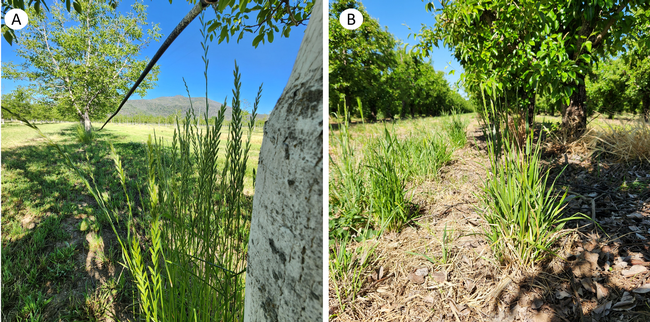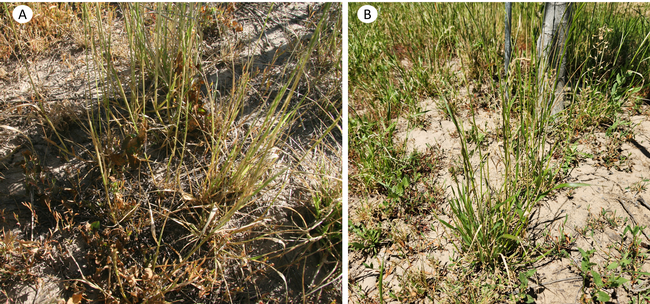In California, Italian ryegrass [Lolium perenne L. spp. multiflorum (Lam.) Husnot] has been around for a long time and is a major weed in orchards, vineyards, field crops, fallow fields, and so on. It grows vigorously in winter and early spring. Italian ryegrass is a short, rhizomatous, that grows from 11 to 35 inches tall, often with erect stems exhibiting purple coloration at the base. That species can be identified by its dark green, glossy, and hairless leaves that are rolled in the bud. Auricles are well-developed and the shape can vary from clasping to blunt, and the ligules are long and membranous. Once flowering occurs, Italian ryegrass is easily distinguishable by alternating spikelets that run along the length of the main seed head stem. The seed heads range from 3 to 12 inches and consist of solitary small stalkless spikelets (Fig. 1). Additional details regarding identification can be found on the UC IPM website.
Also called annual ryegrass, Italian ryegrass herbicide resistance and management strategies have been the topic of discussion among growers, PCAs, UC Cooperative Extension farm advisors, and UC weed science specialists. Because Italian ryegrass has been controlled in crop production systems mainly with herbicides for decades, since 1998, populations of Italian ryegrass have been documented to be resistant to herbicides (Fig. 2). In California, the first report of Italian ryegrass glyphosate-resistant was in 2008 in almond orchards and vineyards, and the evolution and spread of these populations in the state made alternative postemergence herbicides an important management strategy against this troublesome species (published by Jasieniuk et al. 2008, Weed Sci. 2008).
Repeated herbicide use has selected Italian ryegrass populations resistant to multiple of herbicide mode of actions. A recent Weed Science publication by Dr. Brad Hanson's lab confirmed multiple Italian ryegrass resistance to the herbicides paraquat (Gramoxone® 2.0 SL), clethodim (Envoy Plus®), and glyphosate (Roundup PowerMax®). A second study conducted in Dr. Hanson's lab also confirmed that another Italian ryegrass biotype population collected in Hamilton City, CA is resistant to paraquat (Gramoxone® 2.0 SL), clethodim (Envoy Plus®), glyphosate (Roundup PowerMax®), and Mesosulfuron-Methyl (Osprey®). It should be noted that ryegrass populations resistant to fluazifop-butyl (Fusilade® DX), glufosinate-ammonium (Rely® 280), and sethoxydim (Poast®) also have been reported in other cropping systems elsewhere in California.
Worldwide Italian ryegrass has been identified as resistant to 29 herbicides, from 8 different groups of classification with multiple resistance to 1, 2, 3, or 4 sites of action (WeedScience.org, 2022). The most recent Italian ryegrass biotype was identified in a soybean and winter wheat field in North Carolina with multiple resistance to 4 sites of action (clethodim, glyphosate, nicosulfuron, and paraquat).
Management Strategies
For efficient management of Italian ryegrass, integrated weed management (IWM) practices must be adopted that allow the combination of various control strategies, including preventive, cultural, mechanical, physical, biological, and chemical control.
Prevention Control: Avoiding dispersion and introduction of Italian ryegrass into the property and ensuring that seeds and equipment are free of Italian ryegrass contaminants is one of the main strategies in the IWM programs.
Physical Control: Soil tillage may be used as one strategy to be added to the IWM toolbox. Italian ryegrass seeds buried in the soil die quickly and must be close to the surface to emerge. So, this practice can help suppress the population and provide long-term control.
Chemical Control: Italian ryegrass control using PRE and POST herbicide management programs continues to be the most effective. A well-designed herbicide application program with a combination of PRE- and POST-emergent herbicides (e.g., fluazifop-butyl (Fusilade® DX), glufosinate-ammonium (Rely® 280), pyroxsulam (SimplicityMT), rimsulfuron (Matrix®SG), sethoxydim (Poast®), flumioxazin (Chateau®), oxyfluorfen (GoalTender®), pendimethalin (Prowl H2O), and so on are possible options) still been quite effective in controlling Italian ryegrass. Growers should always consult a PCA and a local UCCE farm advisor to help design herbicide application programs and application rates appropriate for their unique growing system. Growers should also keep in mind that they need to avoid repeated herbicide use to prevent resistance in Italian ryegrass populations. Herbicides with different modes of action on a rotational basis should be encouraged to suppress the Italian ryegrass population and provide long-term control.
The growers also may adopt non-synthetic herbicide products for Italian ryegrass control. Among those available commercial products, the active ingredients, including acetic acid (Weed Pharm®), citric acid + Clove oil (BurnOut®), caprylic acid + capric acid (Suppress®), pelargonic acid + related fatty acids (Scythe®), D-limonene (AvengerAG®), ammonium nonanoate (Axxe®) and others, have been used for the non-selective control of that weed. Usually, organic herbicides are recommended for grass and broadleaf weeds in the early stages of growth. For Italian ryegrass already established, organic herbicides have shown poor effectiveness, and recovery approximately two weeks after treatment application (Fig. 3). Studies have shown that organic herbicides applied to control Italian ryegrass may require late sequential application due to the non-systemic characteristics of these products (ongoing trials by Clebson Gonçalves, 2023).
Even with the increase in herbicide-resistant weeds, herbicide control options continue to be the most effective and used option for producers because of time and money. However, diversified management practices should be encouraged as they are crucial for crop productivity, efficiency, saving cost, and sustainability of the systems.
Clebson Gonçalves is the UC Cooperative Extension Diversified Agriculture Advisor in Lake and Mendocino counties.


